
We’ll conclude the offensive side of the team with the trenches.
We’ll conclude the offensive side of the Buccaneers’ all-quarter-century team with a breakdown of the team’s best(ish) offensive linemen of the last 25 years.
Let’s hear it for Fat Boy Friday.
Left Tackle
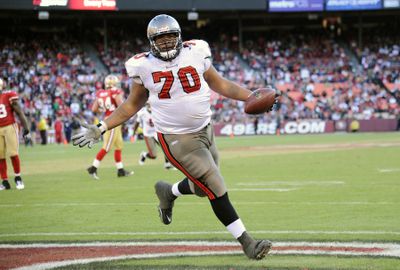
Photo by Thearon W. Henderson/Getty Images
First team: Donald Penn
There weren’t many constants in the late aughts and early 2010s for the Bucs, but Donald Penn served as one of them.
An undrafted free agent out of Utah State in 2006, Penn floated around the bottom of the roster for a year before earning 12 starts in 2007, which was enough to secure the long-term blindside spot. He proceeded to spend seven seasons with the Bucs and start 108 straight games, getting a Pro Bowl nod and even catching a couple touchdown passes on top of it.
Penn was never flashy, and he had a rough year or two, but he made up for it with nastiness, tenacity, and smarts. He played left tackle at a generally good-to-great level before the Bucs unceremoniously cut him in 2014 to replace him with Anthony Collins. We probably all remember how that went.
He proceeded to play six more quality seasons with the Raiders and Washington and earned more Pro Bowl nods before calling it quits in 2020.

Photo by Cooper Neill/Getty Images
Second team: Donovan Smith
Donovan Smith’s reputation among fans is polarizing, to put it nicely. Whether you hate him or, well, tolerate him, Smith started all 124 games he appeared in for Tampa after being drafted in the second round of the 2015 NFL Draft, which is remarkably consistent. The only games he missed came in the final season of his tenure in 2022.
While the beginning of Smith’s Bucs career saw him be way more of a turnstile than one would like, Smith started improving around 2018-19 and eventually fashioned an impressive stretch during the team’s competitive apex with Tom Brady – who definitely helped with his pocket awareness and quick trigger but nevertheless.
In the end, he was a good blindside protector for a championship-winning team and put in eight solid overall seasons, so he could’ve been much worse.
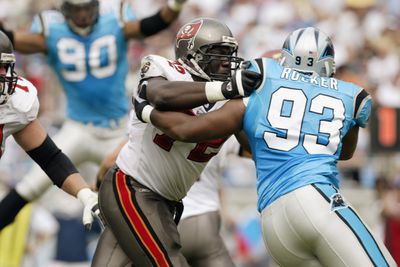
Photo by Craig Jones/Getty Images
Honorable mention: Roman Oben
With Penn and Smith eating up 15 of the last 25 years, down-ballot candidates aren’t exactly awe-inspiring. So with that in mind, we’ll give some flowers to another player who built his career off unspectacular dependability.
Most of Roman Oben’s NFL tenure took place before joining the Bucs in 2002. A third-round pick in the 1996 draft, he played six years for the New York Giants and Cleveland Browns before the Bucs scooped him up on a one-year deal to displace former starter Kenyatta Walker, a first-round pick who struggled immensely as a rookie at left tackle the season prior and was getting kicked over to the right side.
With Oben’s veteran leadership, he helped galvanize a unit that struggled with running the ball under Jon Gruden’s new offensive scheme during the first part of the season. Over the final seven games, including the playoffs, Tampa averaged more than 118 rushing yards per game and logged six of their 10 rushing touchdowns, further enhancing the lethality of that all-time great defense. Individually, Oben also didn’t allow a sack during the playoffs.
He started 29 games for the Bucs before being traded to the Chargers, but his tenure was as important as any offensive lineman’s on the team for quite a while.
Left Guard
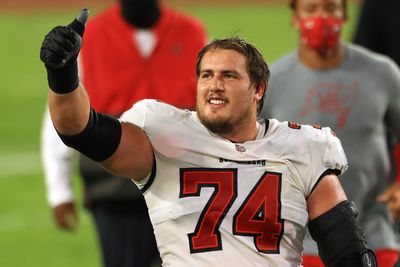
Photo by Mike Ehrmann/Getty Images
First team: Ali Marpet
You could stick Ali Marpet at either guard spot or center and it would be deserved all the same.
One of the greatest small-school players of all-time, Marpet became the first Division III athlete ever drafted in the second round when the Bucs called his name at 61st overall in the 2015 NFL Draft.
Part of Marpet’s rise from his frugal beginnings lay primarily with his athleticism – he tested elite at the NFL Combine and looked like the best player at that year’s Senior Bowl. But above all else, Marpet exemplified incredible football character, leadership, and sheer intelligence. He quickly became one of the NFL’s better interior players with his first two years at right guard before playing center and left guard at elite levels from 2017-2021.
A multi-time team captain, Marpet formed an incredible battery during the Super Bowl season in partnership with Ryan Jensen and Alex Cappa to give Tom Brady elite levels of protection and spearhead a run game that found its groove at the right time in the playoffs.
Marpet decided to retire at just 28 in 2022, satisfied with his career achievements and financial earnings and forgoing any more risk for serious injury. He deserved more than the one Pro Bowl he got, as is true with many other Bucs players in the modern age, but he’ll always be fondly remembered by Bucs Nation.

Photo by J. Meric/Getty Images
Second team: Jeremy Zuttah
Back to the theme of unremarkable dependability, Jeremy Zuttah was sort of Marpet before Marpet – just a step or two below.
A third-rounder out of Rutgers in 2008, Zuttah spot-started a few games at right guard as a rookie before earning a full-time role at left guard the following year. He would bounce between that spot and center over the next five seasons, starting 71 games overall and forming a generally reliable guard tandem with Davin Joseph.
While he eventually got traded away to the Baltimore Ravens in 2014, hence prompting Marpet’s drafting, Zuttah played well for Tampa more often than not and operated as part of the solution, not the problem.

Photo by Cliff Welch/Icon Sportswire/Corbis/Icon Sportswire via Getty Images
Honorable mention: Logan Mankins
If he felt like putting in more years, Logan Mankins could’ve carved out more of a reputation as a Buccaneer…but then you look at how horrendously awful and dysfunctional the team was in 2014-15 and then you don’t really blame him as much.
A multi-time All-Pro and Pro Bowler with the New England Patriots, Mankins played elite football for one of the best teams in the league before his high cap number landed him in Tampa, at the time desperately in search of a replacement for Carl Nicks – you may remember him as an another high-paid All-Pro who played just 9 games with Tampa due to toe issues and a terrible MRSA infection.
One wouldn’t have blamed him for pulling a Jake Plummer, but Mankins suited up and kept doing what he did best his whole career: beat the absolute breaks off basically every defensive lineman he faced. In 31 starts with Tampa, Mankins remained a very good football player who even made the Pro Bowl in his final season at age 33.
It was a dismal era for the Bucs as a whole, but credit to Mankins for showing up and doing his job better than most of his peers and trying to establish a culture. It didn’t work, but at least he tried!
Center

Photo by Kevin C. Cox/Getty Images
First team: Ryan Jensen
It’s hard to express how much Ryan Jensen meant to the culture shift during the Buccaneers’ Super Bowl-winning season and beyond. One could argue he stood as one of the main drivers behind that metamorphosis, side by side with Tom Brady and head coach Bruce Arians.
The Bucs signed Jensen to the richest contract for a center in 2018, and he did not let them down. During his time, he prowled the trenches as not just an elite lineman but as one of the meanest, toughest SOBs to play in recent history.
A glass-eater, a bully, an a**hole; whatever colorful language you choose to deploy, it fits all the same. But above all else, Jensen hated losing, and his pure grit clearly rubbed off on his squadmates over five seasons.
He started 65 games for the Bucs in four years before his tragic pre-season knee injury in 2022. True to form, he fought back from the impossible to start the team’s Wild Card game against the Dallas Cowboys but just couldn’t return to NFL-ready shape and retired soon-after.
A fan favorite and instrumental contributor, Jensen’s time in red and pewter won’t be soon forgotten.
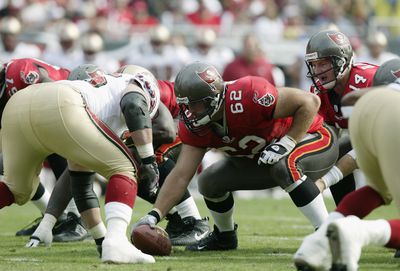
Photo by Craig Jones/Getty Images
Second team: Jeff Christy
In a similar scenario to Roman Oben, the Bucs opted for a grizzled free agent veteran in the early 2000s to help solve their offensive line woes. Pre-dating Oben, however, Christy plugged a massive hole at center when he came to Tampa in 2000. In his prior seven years with the Minnesota Vikings, Christy came to be a Pro Bowl and All-Pro level player.
In his final three years in the league from 2000-2002, Christy maintained a high level of play, earning an additional Pro Bowl nod and serving as the starter on the Super Bowl 37 team. He played and started all but one game during his time in the bay (47 starts), including an additional five playoff games.
The Bucs opted to cut him in a salary-saving measure in 2003, but he decided to retire a champion, undoubtedly a foundational piece of the puzzle for that first Lombardi Trophy.

Photo by Tom Hauck/Getty Images
Honorable mention: Jeff Faine
One of the more unheralded Buccaneers during his time, the Bucs received four years of quality, borderline Pro Bowl play from Jeff Faine from 2008-11 after bringing him in as a free agent.
He started 51 games and helped galvanize a young unit between himself, Donald Penn, Jeremy Zuttah, Davin Joseph, and Jeremy Trueblood. While injuries bit him more times than you would’ve liked to see (he missed 13 games during his tenure), the former first-rounder showcased his excellent smarts and athleticism on a routine basis.
Say it with me again: Unremarkable. Dependability.
Right Guard
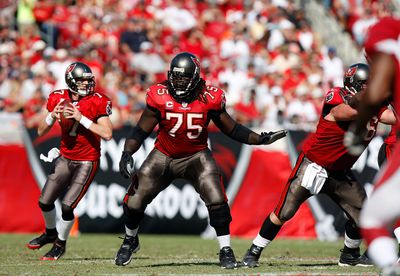
Photo by Allen Kee/Getty Images
First team: Davin Joseph
Needing to reset a lagging offensive line in the mid-2000s, the Bucs invested their 2006 first-rounder in a talented guard from Oklahoma: Davin Joseph.
They received everything they could’ve hoped for when Joseph went on to start 112 out of 116 games over seven seasons. Joseph not only provided a reliable presence, save for 2012 when he suffered a pre-season knee injury, but he also gave Tampa a high level of play more often than not.
He twice earned Pro Bowl nods (2008 and 2011) and was regarded among pundits as one of the best right guards in the league for a significant stretch of time. When you pick an offensive lineman in the first round, it’s hard to ask for much more than what Joseph gave the Bucs.
Add in his off-field philanthropy (twice named a Walter Payton Man of the Year candidate), and you have one of the better reputations in recent Bucs lore.
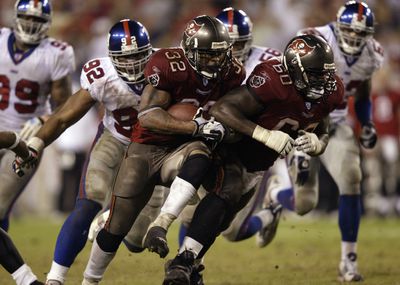
Photo by Matthew Stockman/Getty Images
Second team: Cosey Coleman
As one of the young pieces of the aforementioned early 2000s O-line overhaul, Coleman came to the Bucs in 2000 as a second-round pick after they traded up for him.
He played sparingly in his rookie year but fully took over the right guard spot in 2001, and from there he became a fine contributor during the Super Bowl run and beyond. He and Kenyatta Walker were hardly a perfect pair on the right side, but they were adequate enough for the team’s championship win at least.
Overall, Coleman started 63 games for the Bucs 2000-04. He never reached the heights his potential signaled, but it’s hard to complain about someone who adds something to your roster for half a decade.
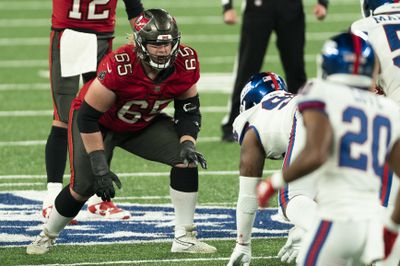
Photo by Cooper Neill/Getty Images
Honorable mention: Alex Cappa
Alex Cappa served as the second edition of Jason Licht’s now tried-and-true “draft smaller school offensive lineman” approach when the latter selected the former in the third round of the 2018 draft.
A product of Humboldt State in California, Cappa played sparingly in his rookie year and endured some bumps in the road his sophomore campaign when becoming a full-time starter (including a literal broken arm that he just kept playing through). However, it all started to click during the Super Bowl season when he became one of the better guards in football.
Sadly, Cappa broke his ankle in the Wild Card game against Washington and missed the Big Game, but he returned in 2021 fully recovered and played well once again to earn himself a big-time contract with the Cincinnati Bengals.
While it would’ve been nice to see his tenure extend longer than 52 games (46 starts), Cappa served an important role in the time he was with the Bucs.
Right Tackle
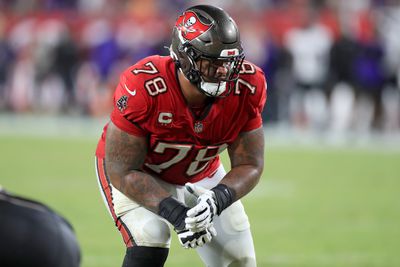
Photo by Cliff Welch/Icon Sportswire via Getty Images
First team: Tristan Wirfs
It is not a stretch to already call Tristan Wirfs not just one of the most dominant Buccaneers of the 21st century, but of all time.
The team’s first-round pick in 2020, Wirfs came in as an athletic marvel out of Iowa tasked with protecting Tom Brady and helping to deliver on the team’s Super Bowl. He simply replied, “No problem.”
He dominated from Game 1 and that has not changed since then. In five seasons, Wirfs has started 79 games and earned four Pro Bowl nods and three All-Pro honors (two first-teams, one second-team). Oh, and he’s done it as a right and left tackle, which is not at all an easy feat.
Just 26 years old and locked up for the long-term, the Bucs have a potential Hall of Famer if Wirfs keeps on his current course and hopefully avoids the nagging knee injuries that have been a concern in the last couple years.
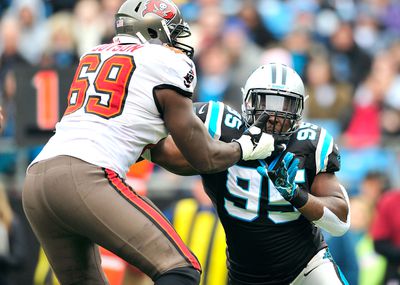
Photo by Grant Halverson/Getty Images
Second team: Demar Dotson
Demar Dotson got very little attention because of being on largely bad Bucs teams, but Tampa’s titanic right tackle deserved much more respect than he ever got.
An undrafted free agent in 2009, Dotson finally earned his place among the starters in 2012 and never looked back. From there, he started at least 11 games or more in seven of the following eight years. He started 106 games total through FIVE coaching regimes, a testament to his reliability.
He was never an overwhelming force, but he rarely got picked on and consistently provided a high floor. He did struggle with penalties at times due to his high-cut frame (he’s 6-foot-9), but he also played multiple years giving up 4 sacks or less.
When being a solid offensive lineman earns you good money, even 10 years ago, Dotson didn’t have to stick around. He could’ve gone elsewhere, but he stayed on team-friendly deals and played hard for 10 years.

Photo by Rex Brown/Getty Images
Honorable mention: Jeremy Trueblood
This is once again a situation where just a few players have made up a majority of the last 25 years, and Jeremy Trueblood is one of them at right tackle.
Trueblood (a second-rounder) came in with Davin Joseph to address Tampa’s O-line woes. The difference between them, however, was that Joseph played well and Trueblood did not. And that largely held true for most of their respective tenures.
Trueblood did start a lot of games, 84 out of 101, but there was never a stretch where you could say he was anything more than adequate. He was nasty but undisciplined – a well-known penalty magnet who got called for double-digit infractions in four different seasons. His aggressiveness and size (6-foot-8, 320 pounds) made him a decent run blocker, but he was also incredibly stiff and allowed an egregious amount of sacks.
So yeah, he wasn’t very good overall, but neither was his competition for this spot (Kenyatta Walker) so I gave the nod to longevity in this case. On a side note, this section is a fitting allegory for the stunning duplexity of this franchise – on one hand you have a Super Bowl-winning wunderkind in Wirfs who’s on a Hall of Fame track, and then you have Jeremy Trueblood, what a rollercoaster.
There you have it for offense, Bucs Nation. Drop any memories you have in the comments, or don’t, I’m not a beggar.
We’ll return on Monday with the defense, which should be fun!